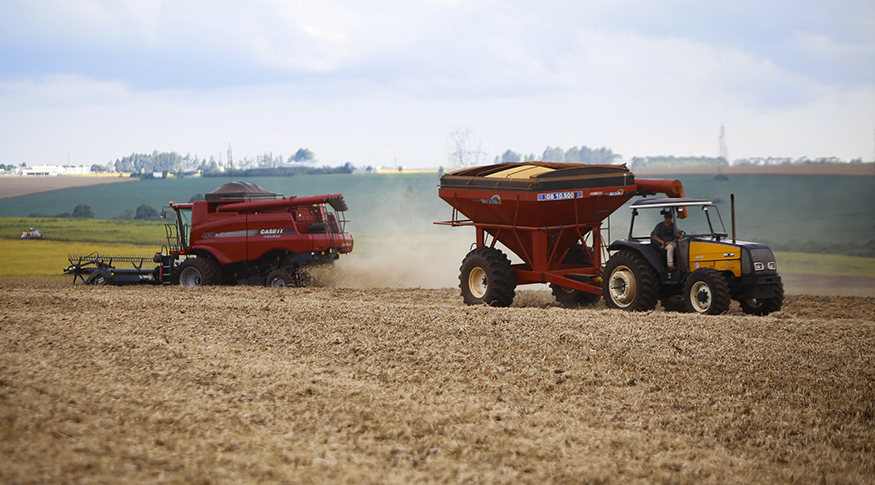Agricultural production
August estimate for 2023 shows record crop of 313.3 million tonnes
September 06, 2023 09h00 AM | Last Updated: September 11, 2023 08h35 PM

Released today (6) by the IBGE, the Systematic Survey of Agricultural Production reveals that the national crop of cereals, legumes and oilseeds should hit a new record in 2023, adding up to 313.3 million tonnes. The figure is 19.0% or 50.1 million tonnes above that of 2022 (263.2 million tonnes). Compared with July, the estimate pointed out a rise of 1.4%, an increase of 4.4 million tonnes.
The area to be harvested should be 77.5 million hectares, representing an increase of 5.8% against the area harvested in 2022 (an increase of 4.3 million hectares), and 0.6% bigger than July estimate.
Compared to 2022, there were increases of 25.8% for soybeans, 10.0% for herbaceous cotton (seed), 38.8% for sorghum, 16.0% for corn, with increases of 10.9% for corn 1st crop and 17.5% for corn 2nd crop, and 8.2% for wheat, while for paddy rice, there was a decrease of 5.5%.
Estimates of soybean production (150.3 million tonnes), corn (127.8 million tonnes, with 28.2 million tonnes of corn 1st crop and 99.6 million tonnes of corn 2nd crop), wheat (10.9 million tonnes) and sorghum (4.0 million tonnes) are expected to hit records. According to LSPA manager, Carlos Barradas, production growth is associated to area increments, bigger investments by producers and to weather conditions, which, as a whole, favored almost all Federation Units.
“The weather has been favorable and, despite Rio Grande do Sul having had a crop failure, the majority of the states have increased their previous estimates, as they reach the 2nd crop phase and see bigger yields. The weather has been helped a lot, especially the second crop products, as corn, whose production grew 17.5% in elation to 2022. Last year, rains started in the proper season, which increases the planting window for corn; prices were good and producers invested more. As to the 19% national production expansion for cereals, legumes and oilseeds, that means 50.1 million more tonnes - a remarkable figure” analyzes Mr. Barradas.
The output of wheat may also hit a record in case the good weather conditions remain. Mr. Barradas claims that wheat is still in the fields and many factors can impact the production, but, for now, it seems that production will hit a record, despite the adjustment in the producing states.
“Paraná reduced its estimate by 1.8% in relation to the previous month, but presented growth of 32.7% in relation to 2022. Rio Grande do Sul presented, in August, a decline of 9.1% in estimates in relation to to 2022, but the state's harvest last year hit a record, reaching 5.3 million tonnes. This decline is somehow small, as the basis for comparison was high. The scenario, so far, is positive, little time is needed to consolidate this good wheat harvest”, says Mr. Barradas.
With a 30.6% share, Mato Grosso leads national grain production
The estimated production of cereals, legumes and oilseeds showed positive annual change for the five Major Regions: the South Region (26.6%), the Central-West (19.4%), the Southeast (8.9%), the North (21.2%) and the Northeast (7.7%). As for the monthly change, the North Region (4.1%), the Northeast Region (0.3%), the Central-West Region (1.6%) and the Southeast Region (3.9%) showed increases. The South Region remained stable (0.0%).
Mato Grosso leads as the largest national grain producer, with a share of 30.6%, followed by Paraná (14.8%), Goiás (10.1%), Rio Grande do Sul (9.4%), Mato Grosso do Sul (8.9%) and Minas Gerais (6.2%), which, together, represented 80.0% of the total. Regarding the shares of the Brazilian Major Regions, the distribution is: Central-West (49.8%), South (26.6%), Southeast (9.7%), Northeast (8.7%) and North (5.2%).
The next release of the LSPA will be on October 10th.
About LSPA
Launched in November 1972 aiming at addressing the demand of users for monthly short-term statistical information, the LSPA provides estimates of planted area, harvested area, amount produced and average yield of products selected based on criteria of economic and social importance for Brazil. It not only follows up each crop investigated in the calendar year of reference, from the intention to plant up to the end of the harvest, but also the forecast of the harvest in the coming year, for which the months of October, November and December are surveyed. Please access the data on Sidra.


















